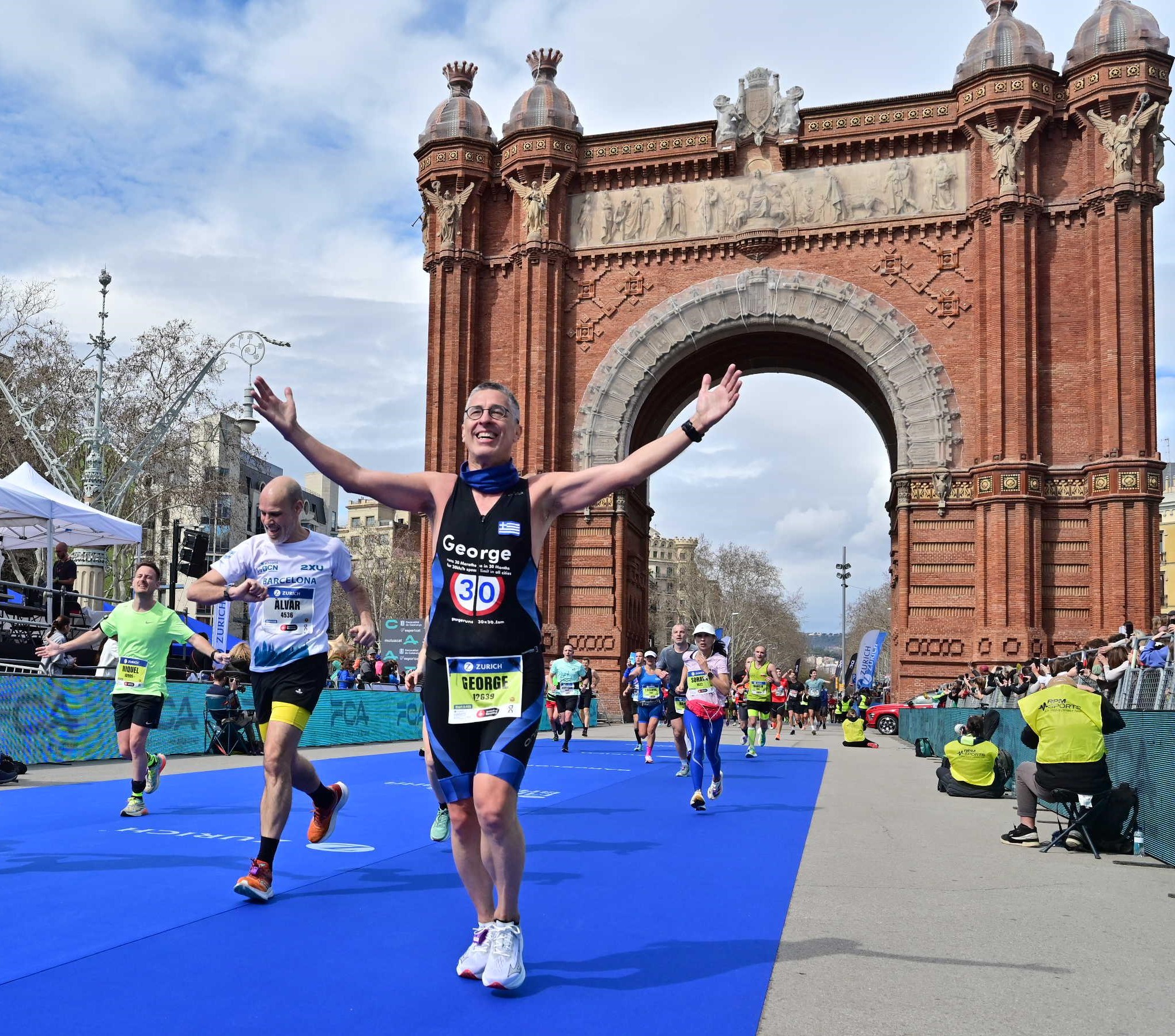How did the idea of this initiative come about?
After more than 30 years of dedication to road safety science and several Marathon races, I decided to combine both passions for a cause: to run 30 Marathons in 30 months in order to actively promote the adoption of 30km/h speed limit in as many cities as possible worldwide, as a key policy for safer, healthier and greener cities.
Road crashes is a major societal problem worldwide, with 1,19 million road fatalities per year and more than 50 million of road injuries and speeding is the number one cause of road crashes worldwide, especially in cities where pedestrians, cyclists and motorcyclists are highly exposed and vulnerable in case of a collision.
The scientists, we urge continuously for lower speeds worldwide, however speeding remains a model and sought behaviour among most drivers and riders, especially the young; very often promoted or largely tolerated by the society, the Authorities and the industry. The voices of vulnerable road users for less speeding remain weak towards our long-established car and speed centred societies.
In the last five years, several European cities (Paris, Brussels, Amsterdam, etc.) have implemented city-wide 30 km/h speed limits (with the exception of major axes) with significant results: an average of 37% reduction in fatalities in road crashes. The discussion and introduction of city-wide 30 km/h speed limit faces strong reactions and rigid inertia, whereas supporters’ voices are weak and inefficient resulting in hesitant politicians and Authorities.
That is the reason why I decided to step beyond the traditional scientific pleas and promote more actively the 30 km/h cities through my challenge of 30 Marathons in 30 months in order to save thousands of lives in Europe and worldwide. And I was surprised and highly motivated by the great support of so many people, experts, the media and key organisations in Europe and worldwide, including ETSC, POLIS, UITP, IRF, ECTRI, joining forces to support Governments and local Authorities towards the new era of 30km/h cities.
Is it worth the effort?
The significance of my challenge extends far beyond the physical feat of covering 1,266 km in Marathons and much more in training. It is about boosting the message for city-wide 30km/h speed limit which has such a great impact on road safety, public health and environmental sustainability in cities. Additionally, it is about fostering a culture of responsible urban planning and encouraging policymakers to implement key measures that prioritize human life and well-being (travellers instead of vehicles).
As I reflect on the kilometres travelled and the countless vivid discussions, I am strongly convinced that every step taken has a very great value, contributing to a higher awareness and understanding of the need for calm traffic by both the Authorities and the society and ultimately saving lives, the highest compensation for my Marathon of Marathon’s challenge. Any life saved from this new mobility paradigm I promote, fully worth all the kilometres run in this highly challenging journey.
Is road safety a long-distance race, similar to a Marathon?
Seeking sustainability in running is very similar to seeking sustainability in urban mobility and this is the message I aim to pass that we need continuous and systematic effort towards slower traffic in cities. Working for safe and sustainable urban mobility is a Marathon and not a sprint effort. As I try to balance my racing and resting speed to sustain my challenge, similarly cities and citizens have to balance speed in the various types of city roads and conditions for sustainable mobility.
In my Marathons (so far 24 for my challenge and 62 in total), I always focus on scientific support in planning and preparation, systematic effort and continuous monitoring and dedication in order to maintain my performance. Exactly, what is needed for the implementation of the sustainable urban mobility with lower speeds and higher quality of life, a lesson I try to promote to both the Authorities and the citizens.
Similar to a Marathon where each step forward contributes to the ultimate goal of reaching the finish line, every action taken to improve road safety, such as implementing lower speed limits, enhancing pedestrian infrastructure or promoting active travelling (walking and cycling) brings us closer to our destination of safer roads everywhere and for all.
Just as in a Marathon, there may be moments of fatigue and challenges to overcome in the enhancement of road safety. However, the rewards of reaching the finish line of each Marathon (saving lives and creating healthier and more sustainable communities) make the journey highly worth the effort.
There will be less pollution…
Scientific evidence demonstrates a very important number of lives saved (an average of 37% from studies in 18 cities) with the introduction of city-wide 30 km/h speed limits but in parallel, significant positive environmental, energy and health impacts with less fuel consumption and more walking and cycling are also found.
International literature demonstrates that city-wide 30km/h speed limit can benefit the environment through the reduced direct and indirect emissions. Specifically, higher speed limits in urban areas are associated with harsh acceleration and deceleration. Calmer and slower driving can decrease emission rates of carbon monoxide, volatile organic compounds and oxides of nitrogen emission rates by up to 17%, 22% and 48%, respectively. In addition, reductions in noise pollution levels by an average of 2.5 dB have been observed and fuel consumption decreased by an average of 11%.
Lastly, the introduction of lower speed limits has minimum or no impact on average traffic speed (especially during the day) and in some cases makes traffic more fluid due to lower speed variations and less start/stops at junctions.
And it encourages active mobility.
Reduced speed limits create progressively a friendly environment for pedestrians and cyclists, making it safer and more enjoyable for them to travel on foot or by bike but also on public transport. Lower speeds reduce reliance on individual vehicles and leads to gradual modal shift from passenger cars to public transport and shared and active travelling, which in turn creates new opportunities for redistribution of public space towards a healthier lifestyle and higher quality of life in cities.
In parallel, this leads to increased physical activity levels among travellers, which has numerous health benefits. Regular physical activity has been associated with reduced risk of chronic diseases, improved mental well-being and enhanced overall quality of life. Not forgetting that calm driving in lower speeds is a means of promoting healthier living also for drivers.
Why else is it important to limit speed in urban areas to calm traffic?
Lower speed limits has been proved to be the only single road safety measure that saves so many lives, so quickly and at low cost. Implementing a city-wide 30km/h speed limit can offer numerous benefits without necessarily requiring high costs, as compared to more extensive infrastructure projects. It has become the safety catalyser expected since long, for quick and efficient improvement of road safety culture and the related significant quick road crashes reduction.
In addition, reduced speeds leading to fewer road crashes and related casualties, result also in lower healthcare costs and less strain on emergency services. Slower speeds can also lead to increased economic activity in cities by creating a more conducive environment for local businesses which boost local economies.
In addition to speed limits, what other measures are needed to improve coexistence between road traffic and vulnerable road users in cities?
A fundamental urban road safety measure is the promotion of Public Transport, which is the safest mode of transport. So, Public Transport safety benefits (often forgotten) should be highlighted together with benefits on mobility sustainability, traffic congestion reduction and fostering more inclusive and accessible urban environment for pedestrians and cyclists.
The new reality brought by 30km/h speed limits, leads and requires infrastructure improvements, designing streets with wider sidewalks, dedicated bike lanes and traffic calming measures that create safer environments for vulnerable road users. Roundabouts and properly managed intersections can slow down vehicle speeds and reduce crash risk. Finally, education and awareness campaigns related to speeding along with the enforcement of traffic laws on speeding can further discourage dangerous behaviour and improve compliance with road safety regulations. Lastly, state-of-the-art technology, Intelligent Transportation Systems and vehicle-to-vehicle communication can enhance the safety of all road users.
How does it change urban design?
The implementation of city-wide 30km/h speed limit might be the catalyser in transforming cities into more liveable, sustainable and inclusive places where safety, accessibility and quality of life are prioritized for all residents and visitors. It represents a major shift towards a more human-centred approach to urban planning, where people are at the heart of design decisions, leading to happier, healthier, and more vibrant communities.
Lower speeds can also create a more pedestrian-friendly environment, encouraging people to walk and explore their surroundings. With 30km/h speed limits, streets are more accessible to people of all ages and abilities, including children and people with disabilities. This fosters a sense of inclusion and ensures that everyone can enjoy the benefits of city life without barriers or limitations.
Why is it so difficult to change mobility habits?
Persistence is the key for Marathon running but also for society changes. Facing reactions and inertia of decades of speed-centred traffic, requires comprehensive and massive information campaigns, based in scientific evidence and patience to gradually change society culture towards safe and inclusive traffic for all.
We often hear passenger car drivers complain that they are safe at 50km/h and they find 30km/h too restrictive. However, 30km/h speed limit is intended to ensure pedestrians’, cyclists’ and motorcyclists’ safety who account for 70% of deaths in road crashes in residential areas in Europe. It is worth working for safer and sustainable behaviour and culture and adopting a calmer driving style for the safety of those outside our cars. At the end of the day, travel time does not increase much (since we stop at intersections anyway) and, ultimately, both drivers and pedestrians have a smoother and healthier life. The quality of life and safety levels which are met in several cities in Europe are based on calmer driving and respect to all road users.
Personally, I will do my best to mobilise the society, the Authorities, the industry and everyone involved in the decision-making process to change the current speedy patterns of city transport towards safe, healthy and green mobility everywhere and for all. Starting with our globally recognised research group, the NTUA Road Safety Observatory and the wide network of our worldwide cooperations, we will ally with everyone who wishes to make the voice of 30km/h Cities as strong as possible, as soon as possible towards safe roads everywhere and for all.
Interview in Dirección General de Tráfico (DGT) magazine in June 2024

